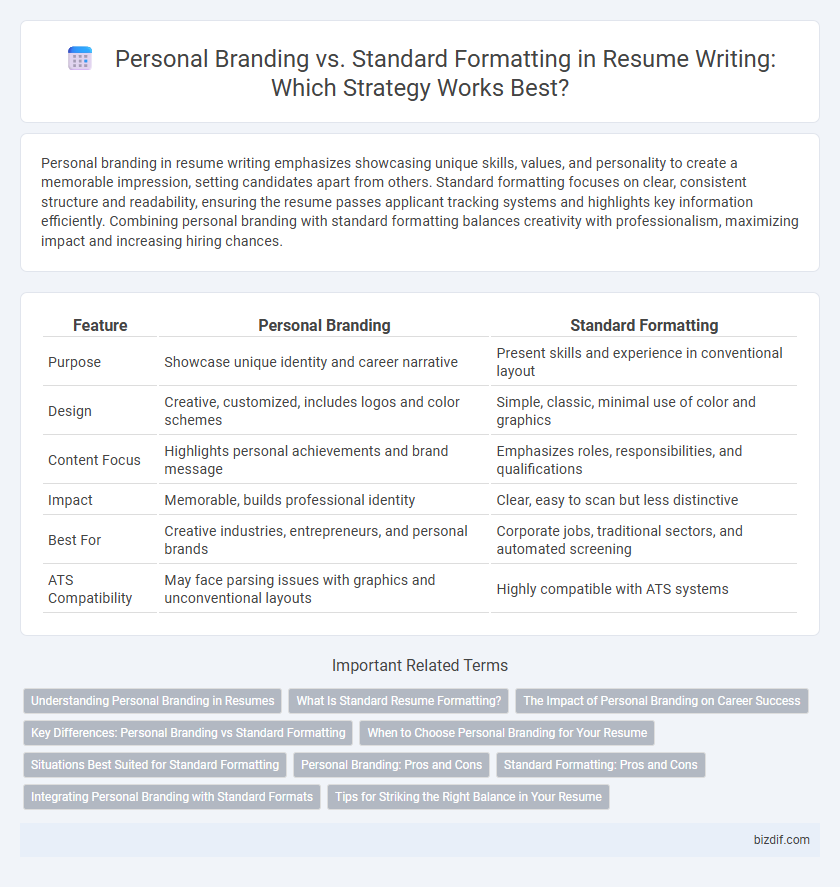Personal branding in resume writing emphasizes showcasing unique skills, values, and personality to create a memorable impression, setting candidates apart from others. Standard formatting focuses on clear, consistent structure and readability, ensuring the resume passes applicant tracking systems and highlights key information efficiently. Combining personal branding with standard formatting balances creativity with professionalism, maximizing impact and increasing hiring chances.
Table of Comparison
| Feature | Personal Branding | Standard Formatting |
|---|---|---|
| Purpose | Showcase unique identity and career narrative | Present skills and experience in conventional layout |
| Design | Creative, customized, includes logos and color schemes | Simple, classic, minimal use of color and graphics |
| Content Focus | Highlights personal achievements and brand message | Emphasizes roles, responsibilities, and qualifications |
| Impact | Memorable, builds professional identity | Clear, easy to scan but less distinctive |
| Best For | Creative industries, entrepreneurs, and personal brands | Corporate jobs, traditional sectors, and automated screening |
| ATS Compatibility | May face parsing issues with graphics and unconventional layouts | Highly compatible with ATS systems |
Understanding Personal Branding in Resumes
Understanding personal branding in resumes involves crafting a unique professional identity that highlights individual strengths, values, and career goals, differentiating candidates in competitive job markets. Unlike standard formatting, which emphasizes uniformity and basic information presentation, personal branding integrates tailored language, strategic keywords, and personalized design elements to create a memorable and impactful resume. Employers are more likely to engage with resumes that convey authenticity and a strong personal brand, reflecting a candidate's distinct value proposition beyond conventional templates.
What Is Standard Resume Formatting?
Standard resume formatting refers to a structured layout using chronological or functional templates that highlight work experience, education, and skills in a clear, easy-to-read manner. Key elements include consistent font styles, bullet points, and section headings to ensure quick scanning by recruiters and applicant tracking systems (ATS). This approach prioritizes clarity and uniformity over personalized design elements commonly emphasized in personal branding strategies.
The Impact of Personal Branding on Career Success
Personal branding significantly enhances career success by distinguishing professionals in competitive job markets through unique value propositions and consistent messaging. Unlike standard resume formatting, personalized branding integrates tailored keywords, achievements, and a professional narrative that resonates with target employers and recruiters. This strategic approach to resume writing increases visibility, credibility, and opportunities for advancement in various industries.
Key Differences: Personal Branding vs Standard Formatting
Personal branding in resume writing emphasizes showcasing unique skills, personality, and professional narrative tailored to attract specific employers, while standard formatting prioritizes clean, consistent layout and traditional sections like education and experience. Personal branding integrates customized design elements, personalized summaries, and targeted keywords to create a distinct professional identity, whereas standard formatting follows conventional templates for ease of reading and ATS compatibility. The key difference lies in personal branding's focus on differentiation and storytelling compared to standard formatting's focus on clarity and uniformity.
When to Choose Personal Branding for Your Resume
Personal branding on a resume is essential when applying for creative roles, entrepreneur positions, or jobs requiring a strong individual identity, as it highlights unique skills and personality beyond standard qualifications. Choose personal branding to differentiate yourself in competitive markets or industries where storytelling and visual impact influence hiring decisions. This approach connects your personal values and professional strengths, making your resume more memorable to potential employers.
Situations Best Suited for Standard Formatting
Standard formatting in resume writing is best suited for industries that value clarity and consistency, such as finance, law, and government roles where ATS (Applicant Tracking Systems) compatibility is crucial. This approach emphasizes clean layouts, uniform fonts, and straightforward sections to ensure automated systems and HR professionals can easily scan qualifications and experience. Job seekers targeting traditional fields or larger corporations often benefit most from standard formatting to avoid formatting errors and enhance machine readability.
Personal Branding: Pros and Cons
Personal branding in resume writing highlights unique skills, values, and career goals, making candidates stand out to employers and increasing memorability. However, it can risk overselling or appearing unprofessional if not balanced with industry standards or clarity. While personal branding fosters differentiation, excessive creativity may confuse applicant tracking systems (ATS) that prefer standard formatting.
Standard Formatting: Pros and Cons
Standard resume formatting ensures clarity and easy readability, which appeals to applicant tracking systems (ATS) and hiring managers by maintaining consistent structure and familiar layout. However, it can limit creativity and personal expression, making it harder for candidates to differentiate themselves in competitive job markets. While standard formats streamline information presentation, they may not fully capture unique skills or personal brand identity, potentially reducing engagement and impact.
Integrating Personal Branding with Standard Formats
Integrating personal branding with standard resume formats enhances candidate visibility by combining unique value propositions with industry-accepted structures, thereby improving applicant tracking system (ATS) compatibility. Customizing resume sections with branded elements such as a professional summary, tailored keywords, and consistent design elevates differentiation without sacrificing clarity. This fusion maximizes recruiter engagement and strengthens the candidate's professional identity in competitive job markets.
Tips for Striking the Right Balance in Your Resume
Effective resume writing requires balancing personal branding with standard formatting to capture attention and maintain clarity. Use a consistent, professional layout while integrating unique elements like a personalized summary, targeted keywords, and specific accomplishments that highlight your value proposition. Emphasize quantifiable results and relevant skills to create a memorable, ATS-friendly resume that appeals to both recruiters and automated systems.
Personal Branding vs Standard Formatting Infographic

 bizdif.com
bizdif.com